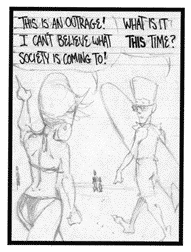
Typical pencil stage. This is an unpublished panel from the transitional period post-LFS and pre-Cool Jerk (hence the hand-lettered dialogue).
Stripping
How do I do it? Well, ideas come from here or there, sometimes in the shower, on the way to work or in conversation with friends. I try to jot down notes in my Palm/Palm Treo/iPhone or sketchbook(s) as soon as possible so I don’t forget them.
Next, I work up the idea. Sometimes it can be contained to a single gag, sometimes it needs to be told over several strips. I sketch out rough (read: primitive) thumbnails in a sketchbook and when I feel halfway confident with the gag I go to the Macintosh.
Using Aldus/Macromedia FreeHand I created a library of pre-made panels (four-panel strips, three-panel strips, Sunday-style pages, etc.). Since I can’t stand to letter by hand, I created a font — Hornopolis — to emulate my oh-so-legible printing (NOTE: many newspaper strips use fonts nowadays, but in 1992 it was pretty much just Cool Jerk and… uh, “Tumbleweeds”).
![]()
Once the dialogue is set up the way I want it, I print the whole shebang out of a laser printer (I use Hammermill Laser Plus paper because it’s brighter than plain bond and it has a subtle coating so ink won’t bleed). I then use a fine-point Sharpie to sketch out the artwork on a blank sheet of paper. Once I’m happy with the composition, I put the printed panels/dialogue over the Sharpie sketch (on a lightbox) and pencil the strip directly onto the printed panels.
Here’s where I get really anal. Over the past 20+ years I developed and perfected an “ink cocktail” for my strip. I use Koh-i-noor Rapidograph India ink, about two parts Rapidraw, two parts Ultradraw and one part Acetate. This mixture allows for smooth ink flow with excellent black coverage and a moderate drying time (important because a quick drying time wreaks havoc with the brush).
I use only one type of brush for the finished inkwork: Robert Simmons 000 E85 round Expression watercolor brush. I used to use the Robert Simmons 000 Aquatip but they stopped producing those in the early 1990s.
I also use Sakura Pigma Micron pens for fine linework and Pelikan Graphic White for any white-ink effects, error correction and touch-ups; accept no substitutes.
That’s pretty much it. I used to use Zipatone for shaded areas but found that it’s not really needed.
UPDATE: I posted a step-by-step to my blog here. Has lots of images of a Cool Jerk in process.
Secret identities
I guess Armpit is the lead character, but I find Puppy closer to my personality. Armpit was originally loosely based on Cory… but now he’s actually more like an amalgam of several people I know. Same with Puppy. Some characters I don’t have any real attachment to, like Maggot and Manuel. But others, like Goremonger and Manhattan, are easy to characterize.



